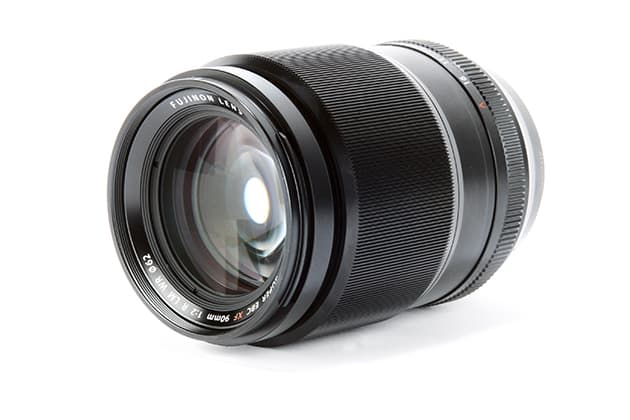Although portraits are often shot on lenses of between 50-85mm, longer lenses from 100-135mm are widely considered to offer a classic portrait focal-length range. With the rapid growth of Fujifilm’s X-mount lens line-up, it was only a matter of time before we saw the brand expand into this area. Earlier this year, Fujifilm launched its Fujinon XF 90mm f/2 R LM WR lens with a 35mm equivalent focal length of 135mm on the Fujifilm APS-C X-Trans sensor cameras. Its fast aperture and long focal length will undoubtedly prove to be a big hit with portrait and wedding photographers, but it has potential applications in other genres too.
Fujifilm Fujinon XF 90mm f/2 R LM WR – Features
The Fujinon XF 90mm f/2 R LM WR houses 11 elements in eight groups. Three of these are extra-low dispersion (ED) glass elements, designed to reduce lateral and axial chromatic aberrations, while Fujifilm’s Nano-GI coating is used to minimise flare and ghosting. The 90mm also boasts an internal focus system, and because the front element doesn’t rotate, the lens can be easily used with polarising or ND grad filters. The lens uses the same 62mm filter thread as the Fujinon XF 56mm f/1.2 and XF 23mm f/1.4.
However, the real star feature of the Fujinon 90mm f/2 is its focal length, which offers the 35mm equivalent of 135mm. This compresses perspective, and quashes much of the distortion of faces that can occur with wider focal lengths. It also has the benefit of giving your subject room to act naturally and, since you’re able to put distance between yourself and the subject, it is not quite as intimidating for timid models.
The lens boasts an aperture range of f/2-f/16. If we keep in mind that the longer the focal length of the lens, the shallower the depth of field, it’s easy to see that the 90mm’s f/2 enables photographers to achieve incredibly shallow depth of field, while rendering backgrounds smoothly out of focus. Portrait photographers especially will love its ability to create distinct separation between subjects and background.
Like the Fujinon 56mm, the 90mm f/2 has seven aperture blades. However, this was criticised on the 56mm, as it gave heptagonal out-of-focus highlights when the lens was stopped down. We suspect many photographers would have preferred a nine-blade aperture and the ability to create more circular bokeh at apertures around f/4.
As with other Fujinon prime lenses, the 90mm doesn’t include optical image stabilisation. At this focal length it could have been a useful addition, although when used for portraits it’s unlikely that the photographer would see much benefit from shooting at slower shutter speeds due to blur from the subject’s movement.
The lens comes included with a cylindrical plastic lens hood, which helps improve contrast as well as cutting out some flare. When reversed, the lens hood sits very close to the lens barrel, giving some decent protection when stored away inside a camera bag, as well as a keeping the packed size down.
Fujifilm Fujinon XF 90mm f/2 R LM WR – Autofocus
Inside the Fujinon 90mm f/2 is a newly developed focusing system. Called the Quad Linear Motor system, it is made up of four focus motors working together to shift the large focusing group inside the lens. This system aims to be quiet, accurate and quick, and Fujifilm claims focusing speeds of 0.14sec.
In use, the autofocus is very quiet and can only be heard very faintly when all other background noise is removed. Even when shooting at a quiet wedding ceremony, nobody would be any the wiser when the lens is focusing. I used the 90mm on the Fujifilm X-T1 with firmware versions 3.2 and 4.0. I shot a number of portraits using flashguns with the model lit solely by a tiny LED light for focusing. Both the speed with which the lens locked on and its accuracy were impressive. With firmware 4.0 the face detection certainly improved, as well as continuous focusing.
In comparison to the Fujinon XF 56mm f/1.2, the lens appears to focus a fraction quicker and, overall, it boasts better consistency and accuracy. While it’s not quite as fast as the Fujinon 16-55mm f/2.8, and can seem a little sluggish at times in comparison, it’s still reasonably quick and very accurate.
Fujifilm Fujinon XF 90mm f/2 R LM WR – Build and handling
 Weighing 540g, the 90mm f/2 is a fairly weighty lens, although that’s to be expected from a large amount of glass and an all-metal construction. At 105mm in length and 75mm in diameter, it sits comfortably and balances well on larger Fujifilm cameras like the Fujifilm X-T1 or Fujifilm X-Pro1. However, on smaller cameras it may feel less balanced.
Weighing 540g, the 90mm f/2 is a fairly weighty lens, although that’s to be expected from a large amount of glass and an all-metal construction. At 105mm in length and 75mm in diameter, it sits comfortably and balances well on larger Fujifilm cameras like the Fujifilm X-T1 or Fujifilm X-Pro1. However, on smaller cameras it may feel less balanced.
It is likely the average camera user can’t remember the plethora of acronyms in most lens names, but the ‘WR’ on the 90mm stands for ‘weather resistant’. It joins the XF 16mm f/1.4R WR in being only the second Fujinon prime lens to feature weather sealing. The extensive rubber gaskets ensure the lens is dust-resistant, weather-resistant and can be used at temperatures as low as -10°C.
Like all Fujinon R-type lenses, the 90mm f/2 has a manual aperture ring that’s adjustable from f/2 to f/16 in 1⁄3-stop increments. Past f/16 a red ‘A’ mark is visible, indicating the lens’s automatic position. Some of the Fujinon aperture rings of old have had handling issues with indefinite clicks and overall looseness. However, the aperture ring on the 90mm has nice firm clicks that prevent accidental movement without being too stiff.
Unlike some Fujinon primes, such as the 16mm f/1.4, the 90mm f/2 doesn’t have either a push-pull focus ring that can be pulled back for manual focus, or a distance scale. However, the manual focusing ring that covers a large amount of the lens handles very well. It focuses by wire, but feels very intuitive with excellent damping and responsiveness.

Fujifilm Fujinon XF 90mm f/2 R LM WR – Image quality

When shot at f/2 with a reasonable distance between subject and background, the bokeh looks fantastic
Many prime lenses lack sharpness when shot at their maximum apertures, but show their true form when stopped down a little. However, images from the 90mm f/2 shot wide open boast impressive sharpness with only a little softness evident in corners. At f/2.8 there’s an improvement in sharpness in both the centre and the corners. Shooting at f/5.6 seems to be the sharpest point of the lens overall, with nice, sharp corners. Further down the aperture range we start to see softness due to diffraction, increasing gradually from f/11 to the minimum aperture of f/16.
Fujifilm corrects certain lens aberrations in-camera, with both vignetting and residual chromatic aberrations removed almost entirely in the camera’s JPEGs. When importing images into software programmes like Adobe Lightroom or Camera Raw, I found the corrections for distortion, vignetting and chromatic aberrations were already set without me even having to check any boxes. In order to see the true characteristics of the lens, images must be imported into Capture One software and all corrections must be marked as off. Our findings show that at the maximum aperture of f/2, there’s around 1⁄2 stop of vignetting, but when stopped down to f/2.8 it largely disappears. Unless users go out of their way to disable corrections, it’s likely that vignetting will never be noticed on an image. As an added bonus, there’s barely any visible distortion.
The 90mm f/2’s true area of interest, however, is to do with the bokeh and the out-of-focus areas it produces. Thanks to its long focal length, large aperture and seven-rounded-blade diaphragm, it creates beautiful bokeh in out-of-focus areas. These are wonderfully circular when shot wide open, and the lens seems even more impressive when you consider that circular bokeh points feature towards the corners too. On stopping down a bit, though, out-of-focus highlights turn heptagonal rather than circular. Despite this, backgrounds generally look smooth and silky, and overall are very pleasingly rendered.
Having used both the Fujinon XF 56mm f/1.6 and 90mm f/2, I find the 90mm renders more attractive bokeh and out-of-focus areas. This is a big achievement, as I hold the 56mm in high regard.
Resolution
 When wide open at f/2 the lens is sharp in the centre, and the corners are only slightly softer. There’s a big jump in sharpness at f/2.8, and not much change in our MTF measurements after that, suggesting the lens has plenty to spare for higher resolution sensors (we tested it on the 16MP X–A1). Best results are at f/5.6, and stopping down further results in progressive softening due to diffraction.
When wide open at f/2 the lens is sharp in the centre, and the corners are only slightly softer. There’s a big jump in sharpness at f/2.8, and not much change in our MTF measurements after that, suggesting the lens has plenty to spare for higher resolution sensors (we tested it on the 16MP X–A1). Best results are at f/5.6, and stopping down further results in progressive softening due to diffraction.
Shading
 Fujifilm uses software correction to reduce shading in its cameras’ JPEG output, but even when looking at uncorrected raw files, shading from the 90mm is very low indeed. We measured just 0.4EV with the aperture set wide open at f/2, and stopping down to f/2.8 eliminates any shading entirely. Indeed, the chances are that many photographers will find themselves adding vignetting in post-processing.
Fujifilm uses software correction to reduce shading in its cameras’ JPEG output, but even when looking at uncorrected raw files, shading from the 90mm is very low indeed. We measured just 0.4EV with the aperture set wide open at f/2, and stopping down to f/2.8 eliminates any shading entirely. Indeed, the chances are that many photographers will find themselves adding vignetting in post-processing.
Curvilinear distortion

Medium telephoto primes tend to be well corrected for distortion, and the 90mm plays true to type. Our tests reveal very slight pincushion distortion, even when looking at raw files with all corrections turned off, but at 0.3% it’s unlikely ever to be visible in real-world images.
Fujifilm Fujinon XF 90mm f/2 R LM WR – Our verdict
Although the 90mm gives superb results when stopped down, what is more important to most users is its performance at maximum aperture, and Fujifilm has absolutely got it right with this lens. Wide open, the lens is really sharp and free from any worrying optical flaws, while the bokeh and out-of-focus areas are delightful for portraits. The autofocusing isn’t as fast as some of Fuji’s lenses, but it’s a definite improvement over the 56mm and is very quiet and accurate. This is important given the very shallow depth of field when shooting wide open.
It’s hard to criticise this lens, but the one thing that goes against it is the lack of versatility of the 90mm focal length.
For portraits, especially tight headshots, the Fujinon XF 56mm f/1.6 does a good job, but the 90mm f/2 just does it better. If the focal length works for the type of photography you do, then put simply, this is a must-have lens.
Score: 5 out of 5










